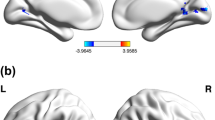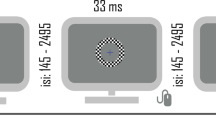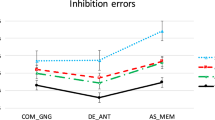Abstract
The 22q11 deletion syndrome (DS) results in the loss of approximately 30 gene copies and is associated with possible physical anomalies, varied learning disabilities, and a specific cluster of neurocognitive deficits, including primary impairment in working memory, executive visual attention, and sensorimotor processing. Retrospective studies have suggested that children with 22q11DS are at 25 times greater risk of developing schizophrenia, thus specification of early brain network vulnerabilities among children with 22q11DS is critical. Previously, we reported that children with 22q11DS as compared with sibling controls had selective deficits in visual executive attention, and subsequently found lowered prepulse inhibition (PPI) in these same children. Visual executive attention and PPI recruit the same brain pathways linking prefrontal cortex to basal ganglia structures. To test the specificity of brain pathway vulnerability among children with 22q11DS, we examined visual executive attention and PPI paradigm data collected during the same test session from 21 children with 22q11DS and 25 sibling controls. We predicted lower %PPI and less efficient executive attention scores, and a significant inverse correlation between measures. %PPI in children with 22q11DS as compared with sibling controls was 20% lower, and visual executive attention efficiency scores 40% worse. As predicted, %PPI was inversely correlated only with executive attention efficiency scores. The implications of these findings with regard to brain pathway vulnerability in children with 22q11DS are considered. These results suggest that children with 22q11DS have early functional abnormality in pathways linking the prefrontal cortex and basal ganglia.
This is a preview of subscription content, access via your institution
Access options
Subscribe to this journal
Receive 12 print issues and online access
$259.00 per year
only $21.58 per issue
Buy this article
- Purchase on Springer Link
- Instant access to full article PDF
Prices may be subject to local taxes which are calculated during checkout

Similar content being viewed by others
References
Botto LD, May K, Fernhoff PM, Correa A, Coleman K, Rasmussen SA et al. A population-based study of the 22q11.2 deletion: phenotype, incidence, and contribution to major birth defects in the population. Pediatrics 2003; 112 (Part 1): 101–107.
Morrow B, Goldberg R, Carlson C, Das Gupta R, Sirotkin H, Collins J et al. Molecular definition of the 22q11 deletions in velo-cardio-facial syndrome. Am J Hum Genet 1995; 56: 1391–1403.
Ryan AK, Goodship JA, Wilson DI, Philip N, Levy A, Seidel H et al. Spectrum of clinical features associated with interstitial chromosome 22q11 deletions: a European collaborative study (see comment). J Med Genet 1997; 34: 798–804.
Pulver AE, Nestadt G, Goldberg R, Shprintzen RJ, Lamacz M, Wolyniec PS et al. Psychotic illness in patients diagnosed with velo-cardio-facial syndrome and their relatives. J Nerv Ment Dis 1994; 182: 476–478.
Murphy KC, Jones LA, Owen MJ . High rates of schizophrenia in adults with velo-cardio-facial syndrome. Arch Gen Psychiatry 1999; 56: 940–945.
Woodin M, Wang PP, Aleman D, McDonald-McGinn D, Zackai E, Moss E . Neuropsychological profile of children and adolescents with the 22q11.2 microdeletion. Genet Med 2001; 3: 34–39.
Sobin C, Kiley-Brabeck K, Khuri J, Taylor L, Karayiorgou M . Neuropsychological characteristics of children with the 22q11 deletion syndrome: a descriptive analysis. Child Neuropsychol, in press.
Sobin C, Kiley-Brabeck K, Daniels S, Blundell M, Anyane-Yeboa K, Karayiorgou M . Networks of attention in children with the 22q11 deletion syndrome. Dev Neuropsychol 2004; 26: 611–626.
Graham FK . Presidential Address, 1974. The more or less startling effects of weak prestimulation. Psychophysiology 1975; 12: 238–248.
Koch M, Kungel M, Herbert H . Cholinergic neurons in the pedunculopontine tegmental nucleus are involved in the mediation of prepulse inhibition of the acoustic startle response in the rat. Exp Brain Res 1993; 97: 71–82.
Koch M, Lingenhohl K, Pilz PK . Loss of the acoustic startle response following neurotoxic lesions of the caudal pontine reticular formation: possible role of giant neurons. Neuroscience 1992; 49: 617–625.
Swerdlow NR, Geyer MA . Neurophysiology and neuropharmacology of short lead interval startle modification. In: Dawson ME, Schell AM, Bohmelt AH (eds). Startle Modification. New York: Cambridge University Press, 1999, pp 114–133.
Ornitz EM . Developmental aspects of neurophysiology. In: Lewis M (ed). Child and Adolescent Psychiatry: A Comprehensive Textbook, 3rd edn. Baltimore: Williams and Wilkens, 2002, pp 87–92.
Ornitz EM, Guthrie D, Sadeghpour M, Sugiyama T . Maturation of prestimulation-induced startle modulation in girls. Psychophysiology 1991; 28: 11–20.
Ornitz EM, Guthrie D, Kaplan AR, Lane SJ, Norman RJ . Maturation of startle modulation. Psychophysiology 1986; 23: 624–634.
Castellanos FX, Fine EJ, Kaysen D, Marsh WL, Rapoport JL, Hallett M . Sensorimotor gating in boys with Tourette's syndrome and ADHD: preliminary results. Biol Psychiatry 1996; 39: 33–41.
Ornitz EM, Pynoos RS . Startle modulation in children with posttraumatic stress disorder (see comment). Am J Psychiatry 1989; 146: 866–870.
Frankland P, Wang Y, Rosner B, Shimizu T, Balleine B, Dykens EM et al. Sensorimotor gating abnormalities in young males with fragile X syndrome and Fmr1-knockout mice. Mol Psychiatry 2004 adv pub online.
Ornitz EM, Hanna GL, de Traversay J . Prestimulation-induced startle modulation in attention-deficit hyperactivity disorder and nocturnal enuresis. Psychophysiology 1992; 29: 437–451.
Schall U, Schon A, Zerbin D, Eggers C, Oades RD . Event-related potentials during an auditory discrimination with prepulse inhibition in patients with schizophrenia, obsessive–compulsive disorder and healthy subjects. Int J Neurosci 1996; 84: 15–33.
Swerdlow NR, Benbow CH, Zisook S, Geyer MA, Braff DL . A preliminary assessment of sensorimotor gating in patients with obsessive compulsive disorder. Biol Psychiatry 1993; 33: 298–301.
Ludewig S, Ludewig K, Geyer MA, Hell D, Vollenweider FX . Prepulse inhibition deficits in patients with panic disorder. Depress Anxiety 2002; 15: 55–60.
Larsen DK, Norton GR, Walker JR, Stein M . Analysis of startle responses in patients with panic disorder and social phobia. Cogn Behav Ther 2002; 31: 156–169.
McAlonan GM, Daly E, Kumari V, Critchley HD, van Amelsvoort T, Suckling J et al. Brain anatomy and sensorimotor gating in Asperger's syndrome. Brain 2002; 125 (Part 7): 1594–1606.
Swerdlow NR, Paulsen J, Braff DL, Butters N, Geyer MA, Swenson MR . Impaired prepulse inhibition of acoustic and tactile startle response in patients with Huntington's disease. J Neurol Neurosurg Psychiatry 1995; 58: 192–200.
Perry W, Minassian A, Feifel D, Braff DL . Sensorimotor gating deficits in bipolar disorder patients with acute psychotic mania. Biol Psychiatry 2001; 50: 418–424.
Braff DL, Geyer MA, Light GA, Sprock J, Perry W, Cadenhead KS et al. Impact of prepulse characteristics on the detection of sensorimotor gating deficits in schizophrenia. Schizophr Res 2001; 49: 171–178.
Swerdlow NR, Caine SB, Geyer MA . Regionally selective effects of intracerebral dopamine infusion on sensorimotor gating of the startle reflex in rats. Psychopharmacology (Berl) 1992; 108: 189–195.
Sobin C, Kiley-Brabeck K, Karayiorgou M . Lowered prepulse inhibition in children with the 22q11 deletion syndrome. Am J Psychiatry, in press.
Posner MI, Boies SJ . Components of attention. Psychol Rev 1971; 78: 391–408.
Mesulam MM . A cortical network for directed attention and unilateral neglect. Ann Neurol 1981; 10: 309–325.
Mesulam MM . Large-scale neurocognitive networks and distributed processing for attention, language, and memory. Ann Neurol 1990; 28: 597–613.
Posner MI, Imhoff A, Friedrich FJ, Cohen A . Isolating attentional systems: a cognitive-anatomical analysis. Psychobiology 1987; 15: 107–121.
Posner MI, Petersen SE, Fox PT, Raichle ME . Localization of cognitive operations in the human brain. Science 1988; 240: 1627–1631.
Sprafkin J, Gadow KD, Salisbury H, Schneider J, Loney J . Further evidence of reliability and validity of the Child Symptom Inventory-4: parent checklist in clinically referred boys. J Clin Child Adolesc Psychol 2002; 31: 513–524.
Shaffer D, Fisher P, Lucas CP, Dulcan MK, Schwab-Stone ME . NIMH Diagnostic Interview Schedule for Children Version IV (NIMH DISC-IV): description, differences from previous versions, and reliability of some common diagnoses. J Am Acad Child Adolesc Psychiatry 2000; 39: 28–38.
Flaten MA . Startle reflex facilitation as a function of classical eyeblink conditioning in humans. Psychophysiology 1993; 30: 581–588.
Graham FK, Putnam LE, Leavitt LA . Lead-stimulation effects of human cardiac orienting and blink reflexes. J Exp Psychol Hum Percept Perform 1975; 104: 175–182.
Blumenthal TD . Inhibition of the human startle response is affected by both prepulse intensity and eliciting stimulus intensity. Biol Psychol 1996; 44: 85–104.
Fan J, McCandliss BD, Sommer T, Raz A, Posner MI . Testing the efficiency and independence of attentional networks. J Cogn Neurosci 2002; 14: 340–347.
Rueda MR, Fan J, Halparin J, Gruber D, Lercari LP, Mc Candliss BD et al. Development of attention during childhood. Neuropsychologia 2004; 42: 1029–1040.
Daniel W . Biostatistics: A Foundation for Analysis in the Health Sciences. New York: John Wiley & Sons, 1991.
Posner MI, Dehaene S . Attentional networks. Trends Neurosci 1994; 17: 75–79.
Bench CJ, Frith CD, Grasby PM, Friston KJ, Paulesu E, Frackowiak RS et al. Investigations of the functional anatomy of attention using the Stroop test. Neuropsychologia 1993; 31 (9): 907–922.
Corbetta M, Miezin FM, Dobmeyer S, Shulman GL, Petersen SE . Selective and divded attention during visual discrimination of shape, color, and speed: functional anatomy by positron emission tomography. J Neurosci 1991; 11: 2383–2492.
Pardo JV, Pardo PJ, Janer KW, Raichle ME . The anterior cingulate cortex mediates processing selection in the Stroop attentional conflict paradigm. Proc Natl Acad Sci USA 1990; 87: 256–259.
Martin JH . The visual system. In: Martin JH (ed). Neuroanatomy. Norwalk: Appleton and Lange, 1989, pp 135–163.
Mountcastle VB . Brain mechanisms for directed attention. J R Soc Med 1978; 71: 14–28.
Wurtz RH, Goldberg ME, Robinson DL . Behavioral modulation of visual responses in monkeys. Progr Psychobiol Physiol Psychol 1980; 9: 42–83.
Petersen SE, Robinson DL, Morris JD . Contributions of the pulvinar to visual spatial attention. Neuropsychol Rev 1987; 25: 97–105.
LeBerge D, Buchsbaum MS . Attention filtering and the pulvinar: evidence from PET scan measures. Program of the 29th Annual Meeting Psychonometric Society, 1988, p 4.
Corbetta M, Akbudak E, Conturo TE, Snyder AZ, Ollinger JM, Drury HA et al. A common network for functional areas for attention and eye movements. Neuron 1998; 21: 761–773.
Kastner S, Pinks MA, De Weerd P, Desimone R, Ungerleider LG . Increased activity in human visual cortex during directed attention in the absence of visual stimulation. Neuron 1999; 22: 751–761.
Shute CCD, Lewis PR . The ascending cholinergic reticular system: neocortical, olfactory and subcortical projections. Brain 1967; 90: 497–520.
Acknowledgements
We thank the children in this study for their hard work, ongoing participation, and invaluable feedback regarding our procedures, and of course, their parents, for their generous commitment to our work. Samantha Monk continues to provide excellent and invaluable assistance with data tracking, data entry, and study administration. We would also like to thank Maude Blundell, MS, for her important contribution to the early recruitment phase of the study, and Kawame Anyane-Yeboa, MD, for his participant referrals. This research was supported by a grant from the Child Health and Human Development Branch of the National Institutes of Health (K08-HD040321, to CS) and also by a General Clinical Research Center grant (M01-RR00102) from the National Center for Research Resources, National Institutes of Health.
Author information
Authors and Affiliations
Corresponding author
Rights and permissions
About this article
Cite this article
Sobin, C., Kiley-Brabeck, K. & Karayiorgou, M. Associations between prepulse inhibition and executive visual attention in children with the 22q11 deletion syndrome. Mol Psychiatry 10, 553–562 (2005). https://doi.org/10.1038/sj.mp.4001609
Received:
Revised:
Accepted:
Published:
Issue Date:
DOI: https://doi.org/10.1038/sj.mp.4001609
Keywords
This article is cited by
-
Executive functioning in preschoolers with 22q11.2 deletion syndrome and the impact of congenital heart defects
Journal of Neurodevelopmental Disorders (2023)
-
Social cognition in 22q11.2 deletion syndrome and idiopathic developmental neuropsychiatric disorders
Journal of Neurodevelopmental Disorders (2021)
-
Thalamic miR-338-3p mediates auditory thalamocortical disruption and its late onset in models of 22q11.2 microdeletion
Nature Medicine (2017)
-
Pre-pulse inhibition and antisaccade performance indicate impaired attention modulation of cognitive inhibition in 22q11.2 deletion syndrome (22q11DS)
Journal of Neurodevelopmental Disorders (2014)
-
Associations between TCF4 Gene Polymorphism and Cognitive Functions in Schizophrenia Patients and Healthy Controls
Neuropsychopharmacology (2013)



